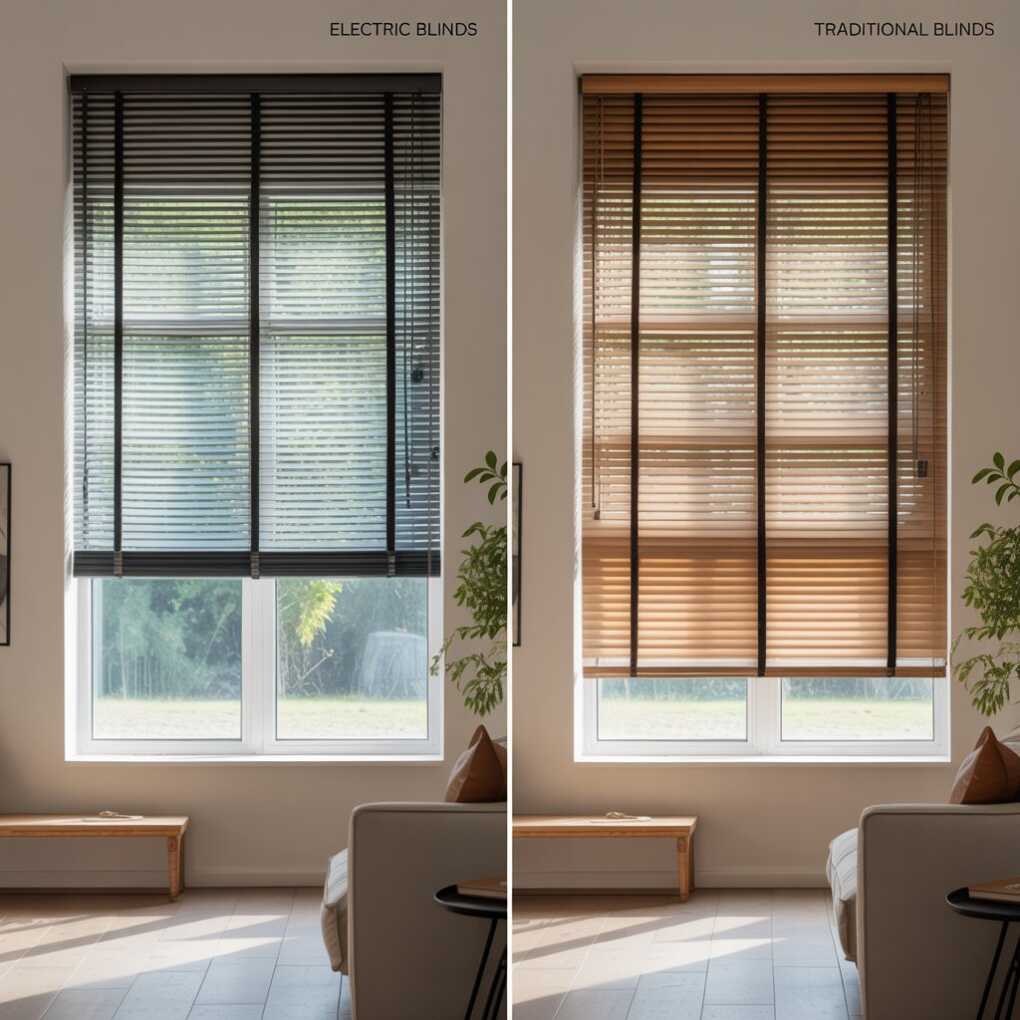Window treatments have come a long way over the years, evolving from simple fabric coverings to modern designs that integrate convenience and technology. Among the most popular choices are electric blinds and traditional blinds, each offering unique benefits depending on lifestyle, budget, and personal preference. Deciding between the two requires considering factors such as ease of use, maintenance, aesthetics, and long-term value. We will explore the differences between electric and traditional blinds, examining the advantages and disadvantages of both options to help you determine which is right for your home or office. By weighing their practicality and functionality, you can make an informed choice that enhances both comfort and style while fitting seamlessly into your daily life.

Key Comparisons Between Electric and Traditional Blinds
1. Convenience and Ease of Operation
One of the most notable differences between electric blinds and traditional blinds is convenience. Electric blinds operate with a motor and can be controlled using a remote, wall switch, or even a smartphone app, making them especially useful for hard-to-reach windows or large spaces. With the simple press of a button, you can open or close multiple blinds at once, saving time and effort. On the other hand, traditional blinds require manual adjustment, which can be less convenient, particularly in larger homes with many windows.
However, for some homeowners, the tactile control of traditional blinds feels satisfying and straightforward. Electric blinds also provide additional accessibility for individuals with mobility limitations, making them an excellent option for ensuring comfort and independence. In contrast, traditional blinds appeal to those who prefer simplicity and don’t mind a bit of manual work to adjust their window coverings. Companies like Final Touch Blinds & Shutters offer both electric and traditional options, giving customers the flexibility to choose what suits their lifestyle. Ultimately, the choice depends on whether you value automation and modern convenience or the familiarity of manual control.
2. Style and Aesthetic Appeal
Both electric and traditional blinds come in a wide range of materials, colors, and finishes, ensuring that style is never compromised. Electric blinds, however, often provide a sleeker and more modern appearance because they eliminate the need for dangling cords or visible adjustment mechanisms. This minimalist look makes them ideal for contemporary interiors where clean lines and uncluttered designs are essential. Traditional blinds, meanwhile, still offer timeless charm, with options such as wooden venetians, roller blinds, or fabric shades that can match a variety of décor themes.
They can bring warmth and character to a room, particularly in rustic or classic settings. The choice between electric and traditional blinds often comes down to the overall design vision of your space. Electric blinds align well with high-tech, modern homes, while traditional blinds remain versatile enough to complement both old-fashioned and modern interiors. Each option allows for customization, ensuring that design preferences are met regardless of the type chosen.
3. Energy Efficiency and Light Control
Controlling natural light plays a significant role in maintaining energy efficiency within your home. Electric blinds provide more precise light control, as they can be programmed to open or close at certain times of the day. This scheduling feature not only enhances convenience but also helps regulate indoor temperatures, reducing reliance on heating and cooling systems. For example, blinds can automatically close during the hottest part of the day to keep rooms cool or open in the morning to allow natural light to warm a space.
Traditional blinds also offer energy benefits but require manual adjustments to achieve similar results. While they can still effectively block out sunlight or allow brightness in, it depends entirely on consistent effort from the user. For those committed to reducing energy bills and maintaining comfort effortlessly, electric blinds present a more advanced option. Traditional blinds, however, can achieve the same outcome for homeowners who are diligent about adjusting them throughout the day.
4. Cost and Long-Term Investment
Price is often one of the most decisive factors when choosing between electric and traditional blinds. Electric blinds generally cost more upfront due to their motorized system and installation requirements. However, they can add value to a property by modernizing it and appealing to future buyers who prioritize smart home features. Over time, the energy-saving potential and convenience of electric blinds may also offset the higher initial cost. Traditional blinds, by comparison, are more affordable and accessible for those on a tighter budget. They provide an effective solution for window coverings without the additional expenses of technology.
Maintenance costs also differ between the two options. Electric blinds may occasionally require servicing or battery replacements, while traditional blinds typically only need cleaning and minor repairs. Ultimately, the choice depends on whether you view window coverings as a long-term investment in technology and convenience or prefer a practical, budget-friendly solution that meets immediate needs.
Conclusion
Choosing between electric and traditional blinds ultimately comes down to balancing lifestyle, budget, and design goals. Electric blinds offer unmatched convenience, safety, and modern appeal, making them a strong choice for those who value technology and long-term comfort. Traditional blinds, however, remain a practical and versatile option, delivering affordability and simplicity without compromising on style. By considering factors such as convenience, cost, energy efficiency, and aesthetics, you can select the window treatment that enhances your space while reflecting your personal preferences. Life at home or work should feel comfortable, stylish, and functional, and the right blinds—whether electric or traditional—play a vital role in achieving that balance.
